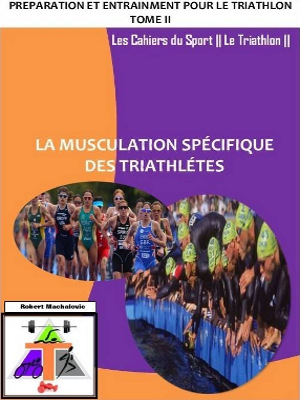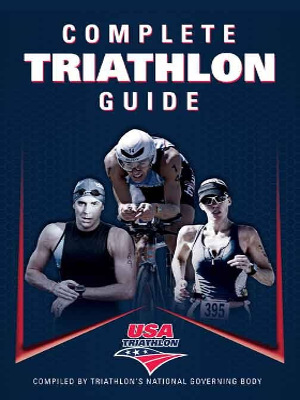
EL HAOUAT MedHassan
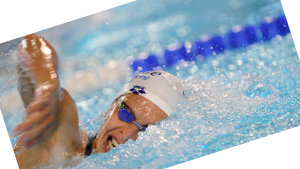 The efficiency of your swimming stroke is the key to success as a competing or training swimmer. An efficient stroke will significantly reduce wasted energy output through less drag in the water and a cleaner execution of hand and arm entry and recovery. Thus that little extra energy may provide you with an overall faster time. When your energy resources are depleted and you're hanging on to the end of your race, you will be the winner if you can hold your technique to that last tenth of a second. Every swimmer knows how easy it is to let one's technique drop off as you become more fatigued throughout a race - that burning sensation in the shoulders as you try to hold together your last few strokes to the wall is the hardest part of the race.
The efficiency of your swimming stroke is the key to success as a competing or training swimmer. An efficient stroke will significantly reduce wasted energy output through less drag in the water and a cleaner execution of hand and arm entry and recovery. Thus that little extra energy may provide you with an overall faster time. When your energy resources are depleted and you're hanging on to the end of your race, you will be the winner if you can hold your technique to that last tenth of a second. Every swimmer knows how easy it is to let one's technique drop off as you become more fatigued throughout a race - that burning sensation in the shoulders as you try to hold together your last few strokes to the wall is the hardest part of the race.
With regard to training for competitions, the season can last for up to 10 months or more, depending on whether you are at county, national or international level. In general, the season's training will reflect the level of the club or squad you are training with. The season will be geared around the county or regional championships, the Grand Prix circuit, the nation short- and long-course championships, the European, World or Olympic Games or the World Cup Circuit. Whatever your level, this article aims to cover the different types of training sets/sessions you should experience. Your individual ability and/or standard will determine the actual proportional breakdown of these sessions or cycles throughout the swimming season.
Although super-high training volumes are the rule rather than the exception for swimmers, there' s solid evidence that these heavy loads may be counter-productive.
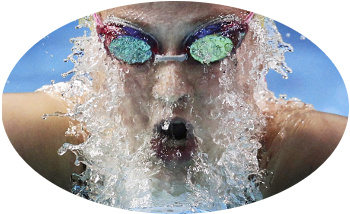 Swimmers train far, far too much. Incredible as it seems, many competitive swimmers scull through 10,000 metres of water per day, spending as much as three hours in the pool. Runners with comparable training programmes would need to cover almost a marathon each day, a schedule that would produce loud cries of derision - or the suspicion that certain record-breaking Chinese females were nearby. Yet, strangely, swimmers treat such training as the done thing.
Swimmers train far, far too much. Incredible as it seems, many competitive swimmers scull through 10,000 metres of water per day, spending as much as three hours in the pool. Runners with comparable training programmes would need to cover almost a marathon each day, a schedule that would produce loud cries of derision - or the suspicion that certain record-breaking Chinese females were nearby. Yet, strangely, swimmers treat such training as the done thing.
Although super-high training volumes are the rule rather than the exception for swimmers, there' s solid evidence that these heavy loads may be counter-productive. A few years ago, the celebrated exercise physiologist David Costill determined at his laboratory at Ball State University that competitive swimmers who cut their training loads from 10000m to 5-6000m per day for a month or two do not lose fitness; in fact, they often IMPROVE their performances. Other investigations in Costill's laboratory have shown convincingly that just 10 days of 110000m per day training actually DECREASES muscle power in swimmers' arms, leading to slower race times.
But swimmers are a tradition-bound lot, so training philosophies aren't likely to change soon. Fortunately, though, there is a way for swimmers to rescue themselves from their high-volume training torture and to perform at peak levels during their most important competitions. What they need to do is taper - reduce their training - for an extended period of time before major races. A period of diminished training allows arm and legs muscles to recover - and then increase - their basic power, helping swimmers to move through the water like torpedoes rather than tortoises.
![]() Triathlon may be the ultimate test of cardiovascular endurance, but triathletes who neglect musculoskeletal strength and flexibility will never fulfil their true potential
Triathlon may be the ultimate test of cardiovascular endurance, but triathletes who neglect musculoskeletal strength and flexibility will never fulfil their true potential
Triathlon is an endurance sport consisting of swimming, cycling and running over various distances. In most modern triathlons, these events are placed back-to-back in immediate sequence, and a competitor's official time includes the time required to 'transition' between the individual legs of the race, including any time necessary for changing clothes and shoes.
While there are various race distances the three most common are Sprint, Olympic and Ironman. Take a look at the breakdown (see table 1 below) for each stage of the event and you can see that when it comes to the Ironman competitors, these are no normal athletes!
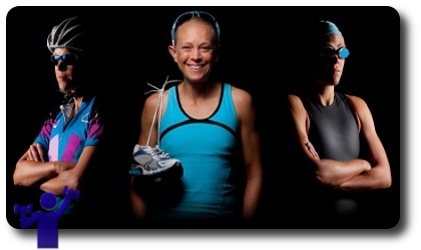 Triathlon has become the most popular multidisciplinary athletic event over the last decade, with competitions performed over a variety of distances, ranging from the triathlon 'sprint' (750m swim, 20k cycle ride, 5k run) to the gruelling Ironman, culminating in a marathon run. Unsurprisingly, therefore, a significant amount of new research is being devoted to investigating the determinants of successful triathlon performance.
Triathlon has become the most popular multidisciplinary athletic event over the last decade, with competitions performed over a variety of distances, ranging from the triathlon 'sprint' (750m swim, 20k cycle ride, 5k run) to the gruelling Ironman, culminating in a marathon run. Unsurprisingly, therefore, a significant amount of new research is being devoted to investigating the determinants of successful triathlon performance.
Most research to date has focused on the cycle-to-run transition, since significant correlations have been reported between cycling or running time and overall triathlon performance. The influence of swimming on subsequent cycling time has been relatively neglected.
However, a new study from France has demonstrated that swimming in drafting position can significantly improve subsequent cycling efficiency and might therefore be expected to improve triathlon performance in general.
The researchers had shown in a previous study that decreasing the metabolic load during a 750m swim by using a wet suit resulted in a 11% decrease in swimming heart rate and led to a 12% improvement in efficiency during a subsequent 10-minute cycling exercise when compared to swimming without a wet suit. The lower relative intensity when swimming with a wet suit is classically explained by a decrease in 'hydrodynamic drag' resulting from increased buoyancy.
Traditional high-volume model of training will not optimise performance
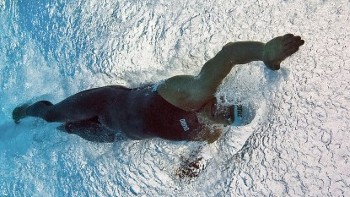 It is probably fair to say that most swimmers and swim coaches see the number of hours spent in the pool as the main ingredient of swimming success and distances of 6-10k per day are not uncommon in élite swimming circles. Is this really the key to success, or is there an alternative approach that can produce even better results? This article aims to stir up the debate by suggesting the traditional high-volume model of training will not optimise performance, especially for 100m and 200m swimmers. It is written not from a swimming coach's perspective but in the light of research on swim training, scientific analysis of the demands of competitive swimming, and running training methods that have been shown to optimise performance. Swimmers should read on with open minds and may then choose to apply some of the principles to their own training programmes.
It is probably fair to say that most swimmers and swim coaches see the number of hours spent in the pool as the main ingredient of swimming success and distances of 6-10k per day are not uncommon in élite swimming circles. Is this really the key to success, or is there an alternative approach that can produce even better results? This article aims to stir up the debate by suggesting the traditional high-volume model of training will not optimise performance, especially for 100m and 200m swimmers. It is written not from a swimming coach's perspective but in the light of research on swim training, scientific analysis of the demands of competitive swimming, and running training methods that have been shown to optimise performance. Swimmers should read on with open minds and may then choose to apply some of the principles to their own training programmes.
Recreational swimmers don't think too much about the precise arm motion that maximizes efficiency and power. Most are simply trying to stay afloat and moving. But elite freestyle swimmers like Kara Lynn Joyce or Michael Phelps have long pondered the ideal technique. Some use what's called deep catch, pulling their arms through the water like a paddle. Others use sculling, which involves swinging the arms to the side like a propeller.
 Olympic swimmers don't just dive into the pool like the rest of us. They start on a block called, appropriately enough, a starting block. London will see the Olympic debut of a track-style starting block with an inclined surface and a lip at the back.
Olympic swimmers don't just dive into the pool like the rest of us. They start on a block called, appropriately enough, a starting block. London will see the Olympic debut of a track-style starting block with an inclined surface and a lip at the back.
The blocks, first used in international competition at the Swimming World Cup in 2009, let swimmers push off from a crouch with the rear leg at a 90-degree angle, optimizing the power of their launch. The block also can detect false starts.
Why does that even matter to a physicist? Because it's all about acceleration.
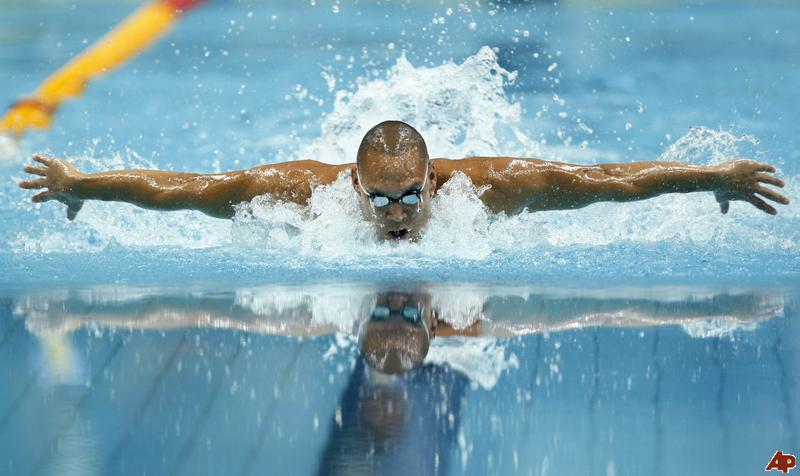 Unless appropriate paces and intensities of work are prescribed for individuals, some swimmers may under-work while others will overwork. The task is to prescribe optimal training activities which involve the correct mix of aerobic endurance, aerobic power, lactate tolerance, and sprint ability. Each of those forms requires different intensities, duration of repetitions, and rest intervals.
Unless appropriate paces and intensities of work are prescribed for individuals, some swimmers may under-work while others will overwork. The task is to prescribe optimal training activities which involve the correct mix of aerobic endurance, aerobic power, lactate tolerance, and sprint ability. Each of those forms requires different intensities, duration of repetitions, and rest intervals.
Sprint ability :
This is one's maximum velocity and is a function of muscle fiber type, level of creatine phosphate in the muscles, activity of creatine kinase in muscles, maximum muscle power, and neuromuscular recruitment patterns. A swimmer has to develop the skill of reaching maximum velocity as soon as possible in a race, to maintain maximum velocity for as long as possible, and develop the ability to call upon sprint ability in the middle and at the end of longer (>30 sec) races.
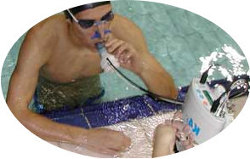 The usefulness of VO2 Max training has been a topic for a few years in the endurance sports world. At the elite athlete level, it is nearly impossible to train an improvement in VO2 Max, and it takes about 10 minutes of training for an athlete to achieve VO2 Max. Cyclists and runners have a large number of competitions that last longer than 10 minutes; swimming has very few. VO2 Max is also extremely difficult to test in the swimming population.
The usefulness of VO2 Max training has been a topic for a few years in the endurance sports world. At the elite athlete level, it is nearly impossible to train an improvement in VO2 Max, and it takes about 10 minutes of training for an athlete to achieve VO2 Max. Cyclists and runners have a large number of competitions that last longer than 10 minutes; swimming has very few. VO2 Max is also extremely difficult to test in the swimming population.
VO2 Max, or the Maximum Volume of Oxygen (O2) that can be consumed while breathing air during exercise at sea level, has always been difficult to measure for swimmers. Cyclists have stationary bicycles that can be precisely calibrated in laboratories while the riders are breathing into gas analyzers, and runners have treadmills, but none of this equipment translates very well to the pool. Many attempts have been made but they have failed to produce useful results. Coaches did what our country does best – improvise, trial & error, and repeat until they created what they felt to be the best approximation of VO2 Max training for their athletes.
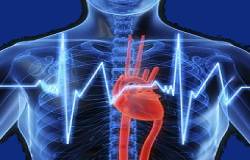 The purpose of training programs in swimming is to produce metabolic, physiological and psychological changes that allow swimmers to perform better in competitions. In swimming, as well as in other sports, aerobic endurance is one of the most important components of the physical fitness of swimmers, while VO2max represents the most objective measure for its assessment. VO2max refers to the maximum amount of oxygen that an individual can utilize during a one-minute exercise. Measurement of VO2max in swimming can be done in three ways, always using a method which is most similar to the swimming conditions during training and competitions. VO2max can be expressed in absolute and relative values, and in the case of elite swimmers ranges from 66 to 80 ml O2/kg/min. According to VO2max values, the work intensity in swimming can be optimized through exercise heart rate and subjective feelings of fatigue. Apart from VO2max, it is very important to measure the percentage of maximal oxygen uptake (%VO2max), which is the highest level of performance that an athlete can maintain over a longer period of time without becoming fatigued. In order to develop and increase VO2max, as well as other factors that influence the development of aerobic or cardio-respiratory endurance, it is advisable to take advantage of endurance training. This type of training can be divided into three levels: basic endurance training, anaerobic threshold endurance training and training above the anaerobic threshold. All three types of training influence the development of resistance, but it is considered that training at the anaerobic threshold is the most significant. Adaptations to training that increase maximum oxygen consumption can be divided into two groups; the first group increases the amount of oxygen that is supplied to the muscles, while the other increases oxygen utilization by the muscles. The latest studies presented in this paper indicate that the prediction of the results and success in swimming, according to the values of maximal oxygen uptake and the impact of training, will always be current in swimming. A single component of success in swimming is rarely the subject of research, in most cases it is usually an entire group of them. Therefore, the aim is to find and develop those factors (characteristics and capabilities) which contribute to the sport results of swimmers.
The purpose of training programs in swimming is to produce metabolic, physiological and psychological changes that allow swimmers to perform better in competitions. In swimming, as well as in other sports, aerobic endurance is one of the most important components of the physical fitness of swimmers, while VO2max represents the most objective measure for its assessment. VO2max refers to the maximum amount of oxygen that an individual can utilize during a one-minute exercise. Measurement of VO2max in swimming can be done in three ways, always using a method which is most similar to the swimming conditions during training and competitions. VO2max can be expressed in absolute and relative values, and in the case of elite swimmers ranges from 66 to 80 ml O2/kg/min. According to VO2max values, the work intensity in swimming can be optimized through exercise heart rate and subjective feelings of fatigue. Apart from VO2max, it is very important to measure the percentage of maximal oxygen uptake (%VO2max), which is the highest level of performance that an athlete can maintain over a longer period of time without becoming fatigued. In order to develop and increase VO2max, as well as other factors that influence the development of aerobic or cardio-respiratory endurance, it is advisable to take advantage of endurance training. This type of training can be divided into three levels: basic endurance training, anaerobic threshold endurance training and training above the anaerobic threshold. All three types of training influence the development of resistance, but it is considered that training at the anaerobic threshold is the most significant. Adaptations to training that increase maximum oxygen consumption can be divided into two groups; the first group increases the amount of oxygen that is supplied to the muscles, while the other increases oxygen utilization by the muscles. The latest studies presented in this paper indicate that the prediction of the results and success in swimming, according to the values of maximal oxygen uptake and the impact of training, will always be current in swimming. A single component of success in swimming is rarely the subject of research, in most cases it is usually an entire group of them. Therefore, the aim is to find and develop those factors (characteristics and capabilities) which contribute to the sport results of swimmers.
S'inscrire Pour Accéder à la Totalité du Site
Conseils Sports Coaching Formation

